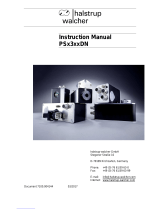
VLT
®
5000/5000 Flux/6000 HVAC/8000 AQUA PROFIBUS
MG.90.D1.22 – VLT is a registered Danfoss trademark
19
Bit 05, Save output frequency/Ramp possible
In the case of bit 05 = “0”, the current output fre-
quency is being maintained even if the reference
value is modified.
In the case of bit 05 = “1”, the frequency converter
can perform its regulating function again; operation
occurs according to the respective reference value.
Bit 06, Ramp stop/Start
Normal ramp stop using the ramp times of the
parameters 207/208 or 209/210.
In addition, activation of the output relay 01 or 04 if
the output frequency is 0 Hz if Relay 123 has been
selected in parameter 323 or 326.
Bit 06 = “0” leads to a stop.
In the case of bit 06 = “1”, the frequency converter
can start if the other start conditions are satisfied.
Note: The selection in parameter 505 determines
how bit 06 is linked with the corresponding func-
tion of the digital inputs.
Bit 07, Without function/Reset
Reset after switching off.
In the case of bit 07 = “0”, no reset occurs.
In the case of a slope change of bit 07 to “1”, a
reset occurs after switching off.
Bit 08, Fixed speed 1 OFF/ON
Activation of the preprogrammed speed in para-
meter 509 (bus JOG 1). JOG 1 is only possible if
bit 04 = “0” and bit 00 - 03 = “1”.
Bit 09, Fixed speed 2 OFF/ON
Activation of the preprogrammed speed in para-
meter 510 (bus JOG 2). JOG 2 is only possible if
bit 04 = “0” and bit 00 - 03 = “1”.
If both JOG 1 and JOG 2 are activated (bit 08 and
09 = “1”), then JOG 1 has the higher priority, i.e.
the speed programmed in parameter 509 will be
used.
Bit 10, Data not valid/valid
Is used to notify the VLT5000 series whether the
process data channel (PCD) should respond to
modifications by the master (bit 10 = 1) or not. The
function can be inverted in parameter 805.
NB!
In the case of bit 10 = 0, the VLT does not
respond to the control word or the main re-
ference value.
Bit 11, Without function/Frequency correction
DOWN
Is used to reduce the speed reference value by the
amount given in parameter 219.
In the case of bit 11 = “0”, no modification of the
reference value occurs.
In the case of bit 11 = “1”, the reference value is
reduced.
Bit 12, Without function/Frequency correction UP
Is used to increase the speed reference value by
the amount given in parameter 219.
In the case of bit 12 = “0”, no modification of the
reference value occurs.
In the case of bit 12 = “1”, the reference value is
increased.
If both – slowing down and accelerating – are
activated (bit 11 and 12 = ”1”), slowing down has
priority, i.e. the speed reference value will be re-
duced.
Bit 13/14, Setup selection
Bit 13 and 14 are used to choose between the four
parameter setups according to the following table:
Setup Bit 14 Bit 13
10 0
20 1
31 0
41 1
The function is only possible if External Selection
has been chosen in parameter 004.
The selection in parameter 507 determines how bit
13/14 is linked with the corresponding function of
the digital inputs.
Bit 15, Without function/Reversion
Reversion of the rotational direction of the motor.
In the case of bit 15 = “0”, no reversion occurs.
In the case of bit 15 = “1”, a reversion takes place.
Please note that the reversion in the factory setting
in parameter 506 has been selected as ”terminal”.
Bit 15 only causes a reversion if bus, bus or termi-
nal or bus and terminal has been selected (bus and
terminal only in connection with terminal 9, how-
ever).
NB!
Unless otherwise indicated, the bit of the con-
trol word is linked with the corresponding
function of the digital inputs as a logical ”or” function.
Control word / Status word





















